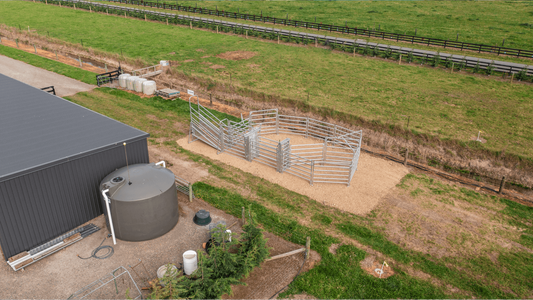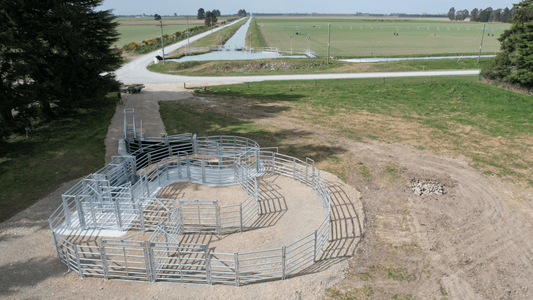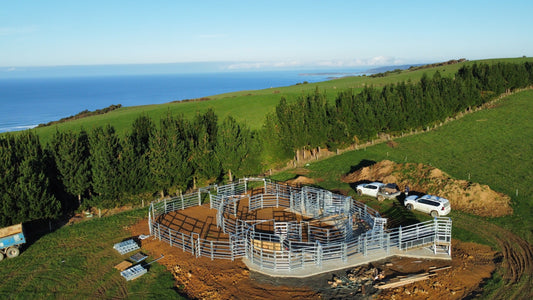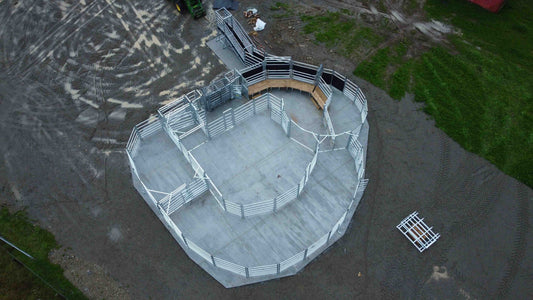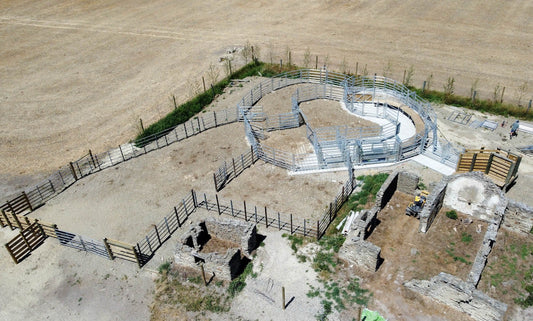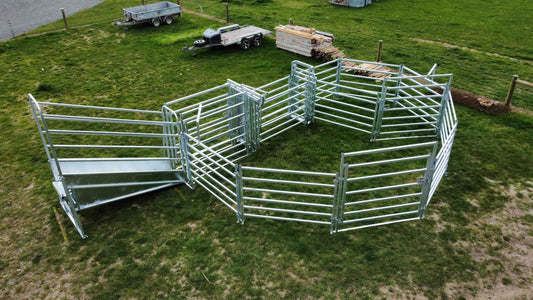When setting up a cattle yard, the site you choose and how well you prepare it can make a huge difference to how your yard performs over time. Good site preparation not only improves stock flow and safety, but it also reduces maintenance and helps your investment last longer.
In this guide, we’ll answer the most common questions around site preparation for lifestyle block cattle yards and share practical tips to help you get it right. You’ll also find a video, where we walk you through the key points step by step.
Do I need to lay a base?
For the best long-term results, we recommend preparing a base before installing your yards. A compacted pad of rotten rock or metal helps prevent common issues over time. For the smallest yards, such as 6-head or 12-head designs, or if you’re on free-draining, compact soils, a base isn’t always essential.
If you’re planning to build your yard without a base, remember that winter stock movement can quickly pug the ground, leading to muddy, uneven surfaces. Over time, this can cause yard levels to shift if the site isn’t solid. A properly prepared pad minimises these problems, improves drainage, and makes your yards safer and easier to work in all year round.

How should I secure my yard?
Most MAXXUS yards are secured using 500mm ribbed ground spikes. As a rule of thumb, two spikes per panel or gate will keep things steady, but if you’re working with stronger or more temperamental cattle, four spikes per panel provide extra security and peace of mind.
For larger set-ups, like a 54-head yard, a more permanent solution is recommended. These yards are often installed on a concrete pad, with panels bolted down using concrete screws. This approach adds durability and keeps everything firmly in place under heavier use.
In contrast, smaller yards with quieter cattle don’t always need to be fixed to the ground. Thanks to its overhead brace design, these yards can stand freely and remain stable, making them a good option if you plan to shift or relocate your yards from time to time.

Should the pad have a gradient (fall)?
When preparing your pad, it’s important to include a slight gradient, or fall, in one direction. This ensures proper drainage and helps prevent water pooling in your yards. Consistency is key, and keeping the fall in a single direction avoids problems with uneven panel connections.
While anti-rattle clamps can accommodate a degree of undulations in the ground, don’t rely on them to pick up too much variation in site prep.
Avoid creating a crowned pad, where the centre is higher than the edges. Crowning can lead to uneven panels and may require additional packing under posts to achieve level connections, adding unnecessary time and effort to the installation.
Do I need to concrete under the head bail?
If you’re working with larger or stronger cattle, it’s a good idea to pour a concrete slab under the head bail. A slab approximately 3 meters long by 1.5 meters wide provides a stable base to securely bolt down the head bale, sliding gate, and adjoining panels.
For smaller or quieter stock, concreting is less critical. In these cases, the yard can still function effectively without a slab, particularly if the base is already well-prepared and level.
For reference, the Head Bails in our yards are about 140kg.

Overhead bracing: When and why?
For larger yards within the Maxxus range, overhead bracing adds structural strength and helps tie the system together. While not essential for smaller setups, it’s recommended where higher stock pressure is expected.
Overhead bracing adds structural strength to larger MAXXUS Yards by tying panels together at the top. This helps distribute pressure evenly and keeps the system stable, making it especially useful for yards handling higher stock volumes or more active animals.
While it’s not essential for smaller yards with quieter stock, adding overhead bracing ensures your panels stay level and reduces the risk of damage. For high-pressure or larger setups, it’s a simple upgrade that makes a big difference in durability and safety.
Using the Yard Plans
Each MAXXUS Yard comes with a detailed plan outlining the yard’s footprint and key measurements. These plans give you everything you need to prepare your site accurately before installation.
Following the specifications in the plan will ensure your yard sits comfortably on your site as intended. Proper site preparation makes setup faster, smoother, and reduces the need for adjustments once your yard arrives.

Understanding Truck Access
Ensuring stock trucks can get in and out easily makes day-to-day operations much more practical and efficient.. When considering truck access for your yard, we recommend checking with your local stock transport operator about access in both summer and winter conditions. Planning ahead ensures trucks can navigate your site safely and efficiently year-round.
Making Use of Existing Infrastructure
When planning your yard site, consider how you can incorporate existing infrastructure, such as laneways and fence lines, leading into the yard. Using what’s already in place, helps improve stock flow, reduces the need for additional fencing or earthworks, and makes your overall yard system more efficient and easier to manage. Not to mention saving a dollar by avoiding unnecessary additional fencing.
Avoiding Flood-Prone Areas
If you’re choosing a site for your yard, select one that is slightly raised and unlikely to experience pooling or flooding, especially during winter. A higher position allows water to drain away from the yards, keeping the area drier, safer, and more practical for both stock and day-to-day operations.
Planning for the Future
When designing your cattle yard, it’s always best to think ahead and plan for potential growth. If you think you might increase your stock numbers in the coming years, consider leaving space to expand your yard or add extra holding pens.
Building flexibility into your layout now saves time, money, and effort later. A well-planned site enables you to adapt as your needs change, keeping your yard efficient, safe, and practical for years to come.
Setting your yard up for success
Proper site preparation is the foundation of a safe, efficient, and long-lasting yard system. From laying a solid base to planning for drainage and truck access, taking these steps now will make your yards sturdier, easier to use, and hassle-free for years to come.
If you’d like additional guidance on preparing your site, contact the team today.


